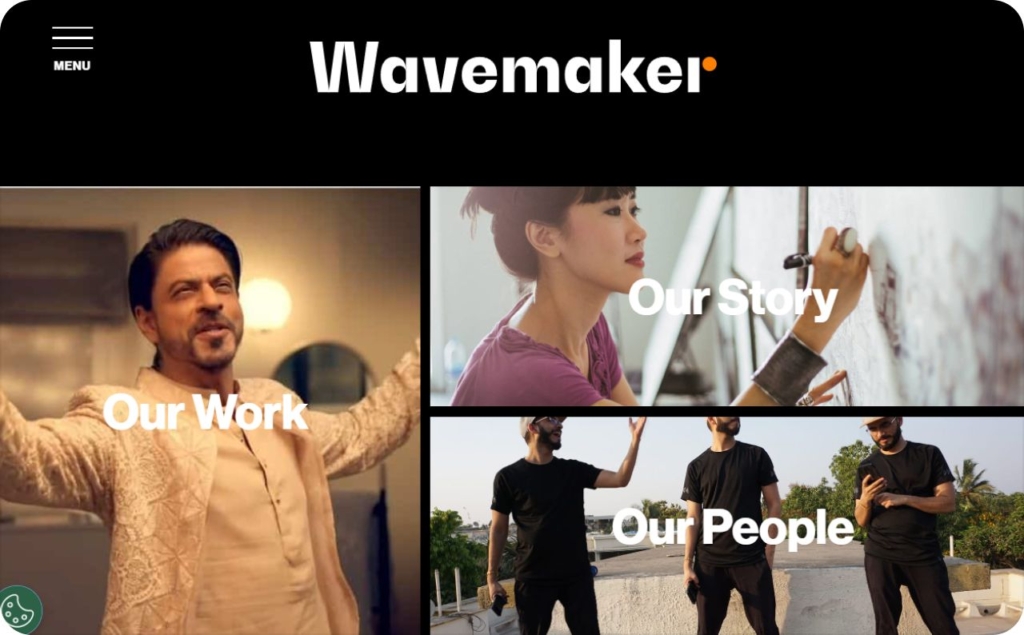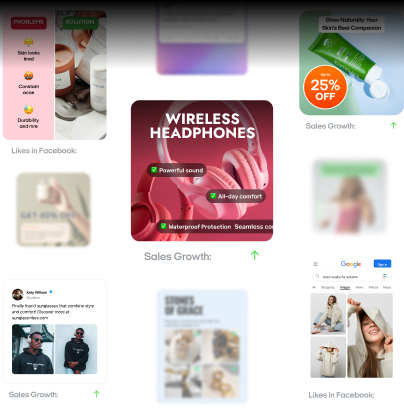What’s dynamic creative and 3 reasons why it matters for your business
Dynamic creative optimization is changing the way marketers approach ad delivery. If you’re tired of low engagement, ad fatigue, and wasted budgets on one-size-fits-all messaging, dynamic creative offers a smarter, scalable alternative. This data-driven approach to personalized advertising ensures every impression is tailored, delivering the right message, to the right person, at the right time.
In fact, 77% of marketers report that AI-powered dynamic creative tools enhance efficiency and brand consistency, highlighting how automation can reduce production friction and unlock creative agility. Whether you’re running campaigns on Meta, TikTok, or DOOH, DCO helps you adapt instantly to changing user behavior.
But how do you actually implement it — and get results that scale? Keep reading to explore real case studies, step-by-step workflows, and channel-specific tactics that show exactly how to turn dynamic creative optimization into measurable campaign performance.

What is dynamic creative and how does it work?
You’ve likely come across terms like dynamic ads, real-time personalization, or programmatic advertising, but understanding how they actually work together can be a challenge. That’s where dynamic creative comes in — a data-driven advertising solution that automatically assembles, tests, and personalizes creative assets such as images, headlines, and calls to action.
Unlike static creative, which shows the same ad to every user, dynamic creative adapts based on real-time signals like browsing history, location, or demographics. This approach ensures that each viewer receives a personalized experience that aligns with their current context and intent.
At the core of DCO is a system of creative automation powered by feed-based data and programmatic delivery. Your product catalogs, CRM data, and behavioral insights are pulled into creative asset management platforms, which generate dynamic ad variations without requiring manual design work.
These automated workflows run multivariate testing across every impression — analyzing which combinations of visuals and copy perform best based on campaign goals. For example, one version of an ad may outperform others for mobile users in the morning, while a different variation may drive higher conversion rates in desktop placements at night.
Programmatic advertising platforms then deliver the top-performing creative to the right audience segments at scale, optimizing every impression for relevance and performance. This isn’t guesswork—it’s algorithmic adaptation built into your media strategy.
And the numbers back it up. According to McKinsey, digital personalization strategies, including DCO, can drive a 10–15% revenue uplift, while certain industries see gains of up to 25%. A Meta study found that personalized AI static ads and video ads can increase short-term sales by 1.2 to 7.4 times compared to generic creative.
With DCO, you’re no longer manually managing assets — you’re deploying data-driven creative that evolves automatically to meet the moment.
The data and automation behind dynamic creative optimization
To understand how dynamic creative optimization delivers performance at scale, you need to look under the hood at how it uses data signals and automation workflows to power real-time personalization.
DCO platforms ingest a combination of behavioral data, including browsing history, purchase activity, demographic attributes, and device type. These data points are funneled into an automated ad assembly engine that builds dynamic variations of each creative element based on what’s most likely to resonate with each viewer.
Using creative asset management systems and feed-based data, the platform dynamically assembles personalized ads on the fly. Each variation is tested continuously through multivariate testing, which compares different combinations of elements against real-world performance data.
When a variation hits predefined thresholds, such as 1,000 impressions or 100 conversions, the system identifies statistically significant patterns. From there, the DCO algorithm automatically prioritizes top-performing combinations, suppressing those that underperform. This ensures each impression is optimized to maximize engagement, reduce ad waste, and increase efficiency.
Feed-based data sources, such as product catalogs, real-time inventory feeds, or location triggers, play a central role in informing which ad variant is served. For example, if a user previously browsed athletic shoes, the system might surface a local in-stock promotion with a “Buy now” CTA, while another user may see a time-limited sale banner for related gear.
And the opportunity is massive. With over 1.6 billion internet users spending an average of 6.5 hours online daily, each digital interaction generates fresh data that feeds back into the system, making your creative smarter with every impression.
This is what makes DCO unique: the ability to integrate real-time data with automated testing and delivery to continuously refine creative performance without manual intervention.
Why DCO matters for your brand
Repetition kills performance. Static ads have a short lifecycle, and consumers quickly tune them out. DCO combats this by algorithmically rotating creative components, such as headlines, product images, and CTAs, based on real-time data signals like browsing history, time of day, weather, and behavioral triggers. This level of contextual relevance extends the shelf life of your creative and sustains engagement over longer flight periods.
Let’s take an example: a skincare brand running DCO pushes out different product images depending on time of day. In the morning, users see a “Brightening vitamin C serum” with a “Start fresh” CTA. In the evening, the same slot shows a “Night repair retinol cream” with “Restore while you sleep.” Both creatives are built from the same template, automatically rendered by the DCO platform using real-time data.
This dynamic variation increases ad lifespan, sustains engagement, and reduces production overhead, allowing you to scale personalization without scaling creative costs.
DCO drives higher CTR through audience-specific optimization
Generic ads miss the mark. Even great creative underperforms when it’s shown to the wrong audience. DCO uses multivariate testing at scale to automatically identify the best combinations of visuals, messaging, and format for each user segment. Machine learning dynamically adjusts delivery in real time to match individual preferences and engagement history.
Consider this: a travel brand runs a single DCO campaign to promote holiday getaways. For users who’ve browsed ski jackets, the ad shows snowy mountain scenes with “Book your Alpine escape” copy. For beachwear shoppers, the same template morphs into oceanfront visuals with a “Find your island paradise” headline. Both experiences are powered by the same campaign logic but dynamically optimized for each user.
This real-time optimization leads to significant CTR lifts, often 25–40% higher compared to static ads, while reducing reliance on manual A/B testing.
DCO maximizes ROAS by allocating spend to high-impact variations
Wasting budget on underperforming creative is one of the most common drivers of low ROAS. DCO continuously evaluates performance indicators and automatically reallocates media spend toward top-performing ad variants.
A telecom brand, for example, uses DCO to personalize ads for its data plan offers. Users located near retail stores see localized pricing with “Visit your local store” CTAs, while online shoppers see “Bundle & save from home” offers. As performance data accrues, DCO deprioritizes low-converting creatives and scales investment into those delivering the best ROI.
The result is a self-optimizing campaign that reduces waste, improves cost-efficiency, and drives stronger returns, without manual reallocation.
DCO streamlines creative management across channels
Scaling creative across platforms often means juggling multiple specs, formats, and approval flows. DCO solves this by letting you build modular ad templates that automatically adapt creative components for each placement, whether it’s Meta, YouTube, TikTok, or Digital Out-of-Home.
Here’s how that looks: an automotive brand uses one core template to promote a new SUV. In New York, the ad shows a city skyline with “Lease the 2024 explorer – $299/mo downtown Ford.” In Colorado, the same ad spotlights off-road terrain with “Adventure starts here – find yours at Boulder Auto.” Both are powered by a central feed that adjusts copy and visuals based on location and inventory.
This method simplifies cross-channel orchestration, reduces production time, and ensures brand consistency, even as you scale to hundreds of variations.
When digital spaces become crowded, dynamic creative optimization helps your brand stand out by delivering adaptive and relevant content. In the next section, you’ll learn how real‑time data integration, programmatic technology, and automated asset assembly work together to power dynamic ads that convert. Get ready to transform your ad personalization approach, stand out in the marketplace, and unlock new growth.
Key takeaways
- 1
+25–40% CTR
Real-time testing matches the best headline/image/CTA to every viewer
- 2
100+ variants per template
Ads stay fresh for weeks with almost zero extra production
- 3
Auto-shifted budget
Spend funnels to top-converting creatives, lifting ROAS and slashing waste
Real DCO cases that show the importance and benefits for business
DCO isn’t just about automating ad delivery, it’s about unlocking performance at scale. Here’s how dynamic creative transforms campaign outcomes across engagement, ROI, and operational efficiency:
Enhanced relevance, higher engagement
Instead of displaying the same ad to everyone, dynamic creative swaps images, headlines, and calls to action based on audience interests.
The Hungarian brand Bónusz Brigád tested this with Facebook’s DCO through Growww Digital. By uploading multiple variants and letting the algorithm choose the best combination, they cut CPC from €0.13 to €0.07, effectively doubling ROI while increasing newsletter subscriptions by 461%. Their CTR also leaped from 0.47% to 2.17%, proving that ad personalization reduces ad fatigue and drives real campaign optimization.
Measurable ROI benefits
If you master static ads, you should know they often lead to wasted spend and poor CTR. By contrast, dynamic creative hones in on the most effective messaging for each viewer. Whether you’re running B2B or e‑commerce promotions, personalized ads help you channel budget where it matters most.
A Wavemaker campaign for a telecom client used dynamic product ads to test variations rapidly, cutting cost per acquisition by 50% and achieving their best year‑on‑year performance yet.

Photo source: Screenshot of Wavemaker website
Scalability and production efficiency
Dynamic creative scales seamlessly across social media, display networks, and beyond — no more manually producing endless ad variations. By combining ad personalization with creative automation, you gain engagement boosts at every stage of the funnel and deliver ROI improvements that directly impact your bottom line.
If you’re still debating whether to switch, remember that static ads remain identical for everyone, quickly losing relevance. Dynamic creative, on the other hand, updates on the fly so you stay ahead in crowded digital spaces.
If you want to cut costs and boost your bottom line, it’s time to embrace dynamic creative. Up next, we’ll walk you through setting up data feeds, running multivariate tests, and refining your creative elements for optimal performance on every platform.
Best practices and industry strategies for DCO
If you want to implement dynamic creative effectively, you need a campaign framework that merges creative automation tools, real-time data inputs, and cross-channel integration. Focus on customizable ad templates, platform-specific creative optimization, and industry-targeted tactics.
Start with smart creative templates
You should begin by crafting dynamic ad templates that allow headlines, images, CTAs, and even pricing details to change based on user signals. These customizable ad templates aren’t static PSD files; instead, they connect to feed-based data like product inventories, geo-targeted offers, or CRM segments via CSV import or direct API links.
Once your DCO platform is synced, it will use multivariate testing to figure out which mix of creative elements boosts operational efficiency and campaign scaling.
By setting up automated variations, you avoid manually building separate ads for every segment. In turn, you get quicker deployment, better ad targeting, and the flexibility to adjust content in real time — an essential step in dynamic creative best practices.
Tailor your strategy by industry
Industry dynamic creative strategies work differently depending on who you’re targeting and what you offer. In e-commerce, using dynamic ad templates with real-time stock levels and pricing ensures each user sees accurate, up-to-date deals. Meanwhile, travel brands can integrate weather feeds or seasonal triggers into their DOOH or social ads, automatically switching visuals if a forecast calls for snow. Automotive marketers often insert local dealership details or financing options based on a user’s location, giving each viewer a laser-focused, relevant offer.
This approach — adapting template customization to unique industry needs — makes it easier to optimize your creative for campaign scaling while maintaining brand consistency.
Adapt to each platform’s requirements
Platforms like Meta or TikTok have very different ad specs and user behaviors. Embrace platform-specific creative optimization by designing vertical, video-forward assets for TikTok and Snapchat, or rotating through multiple product sets in Meta’s Dynamic Product Ads.
For DOOH integration, use supply-side platforms that support real-time ad personalization, so you can rotate billboards based on the time of day, local events, or geotargeted weather updates.
By respecting each platform’s norms, while still leveraging the core automation of your dynamic creative strategy, you stay relevant in every channel and maximize your ad performance.
Move from strategy to execution without overload
Start small if you’re feeling overwhelmed. Pick a single product category or a limited region to test industry dynamic creative strategies, link your feed-based data, and run multivariate tests on different elements, like CTA text, visual themes, or discounts. Track key performance metrics like CTR, CPA, and ROAS to identify top-performing variations, then gradually scale across more product lines or regions.
This step-by-step rollout ensures you capture the benefits of dynamic creative with higher engagement, reduced overhead, and scalable ad campaigns. In the next section, you’ll see how to push this even further by harnessing DOOH advertising in real time and tackling common data-integration challenges, so you can orchestrate cross-channel integration without losing creative control.
Dynamic Creative in Digital Out‑of‑Home advertising
Many advertisers still view out‑of‑home channels as old-school, but Digital Out‑of‑Home advertising is redefining location‑based dynamic creative for modern audiences.
By integrating dynamic digital signage with real‑time ad updates, you can show contextual ads that shift according to weather, local events, or live traffic data. For instance, a digital billboard can display a hot coffee promotion the moment a weather API detects falling temperatures, and it can switch to an umbrella ad as soon as rain is forecast.
You deploy these dynamic DOOH campaigns through Supply‑Side Platforms integration that manage screen inventory in real time, ensuring the right creative appears when and where it’s most relevant.
This process also involves external data integration, such as linking sports scores or flight statuses, to deliver location‑based ads that resonate with consumers on the go. By using dynamic creative within digital out‑of‑home advertising, you bridge the gap between traditional billboards and real‑time personalization, boosting brand engagement and connecting online data to offline screens.
Overcoming challenges and technical considerations
Running dynamic creative across channels isn’t hard because of the creative, it’s hard because of the data. If you’ve ever tried syncing third-party feeds like inventory, pricing, or weather updates, you already know the pain.
Tame the chaos with centralized data
When your feed data isn’t standardized, you get delays, inconsistencies, or worse — broken ads. One weather feed updates every 10 minutes, another refreshes hourly. Your dynamic templates can’t keep up.
That’s where a centralized data integration layer comes in. It cleans, formats, and aligns all incoming data so your creative automation engine doesn’t miss a beat. You’re not just fixing a technical integration problem — you’re building a foundation that keeps your automated ad variations accurate and timely across every impression.
Ensure cross-platform consistency
Even the best dynamic ad creative won’t perform if it looks broken in the wrong format. What works on a Meta carousel may fall apart on a DOOH screen or in TikTok’s vertical feed.
Always preview your creative variations across formats before launch. Double-check your text hierarchy, image scale, and brand consistency. Small tweaks can make or break your campaign. This is where cross-platform ad integration becomes critical, it ensures your creative elements stay aligned, no matter the channel.
Connect performance to creative
Without analytics for DCO, your dynamic creative optimization strategy is flying blind. You need visibility into which creative elements are driving clicks, conversions, or bounce. By tying performance metrics, like CTR, CPA, or conversion rate, back to individual creative variants, you’ll stop guessing and start scaling what works.
It’s not just about optimization. It’s about data-driven creative that learns and improves with every impression. When your feed management is clean, your creative testing protocol is solid, and your campaign analytics are integrated, you’re not just managing complexity, you’re mastering it.
What’s next?
You’ve explored how dynamic creative can power digital out‑of‑home advertising, harness real‑time data feeds, and stay consistent across multiple platforms. Now it’s time to deploy those insights. Here’s a concise ad campaign checklist to start implementing DCO:
- Decide whether you’re seeking more foot traffic, stronger brand awareness, or higher conversions
- Integrate third‑party APIs within a centralized platform
- Use creative testing on DOOH screens, social channels, and web banners to confirm cross‑channel consistency
- Measure engagement, CTR, and CPA using unified analytics for DCO
- Based on results, iterate your creative optimization roadmap, add new data feeds, or expand to more DOOH locations
By following this digital marketing roadmap, you’ll transform your dynamic creative implementation from a theoretical plan into a high‑impact campaign.
If you want deeper insights into creative personalization strategy, consider partnering with specialists or exploring advanced creative automation tools. This approach ensures your brand remains agile, data‑driven, and ready to captivate audiences both online and on the streets.
Also recommended



